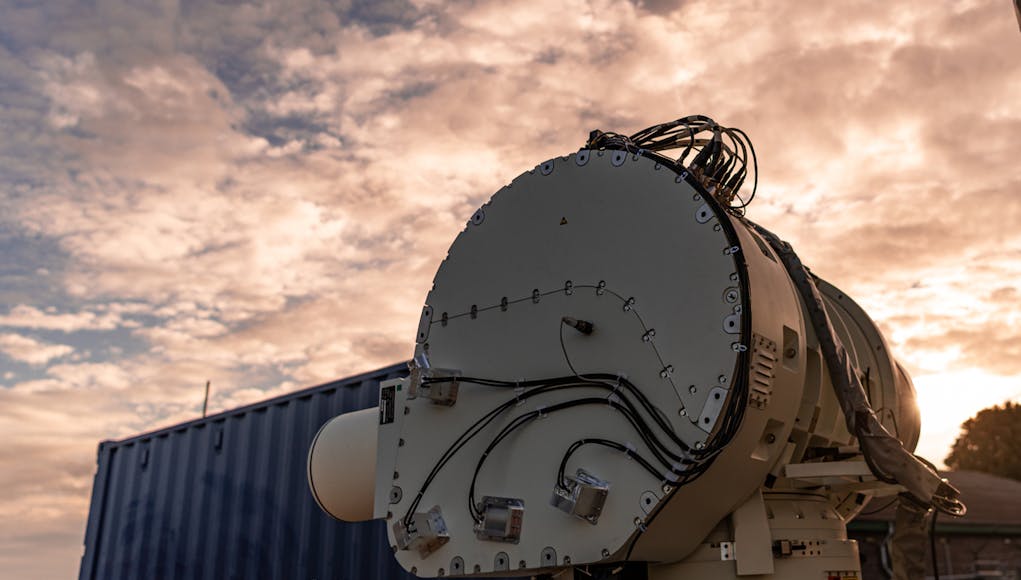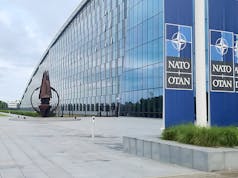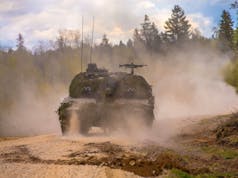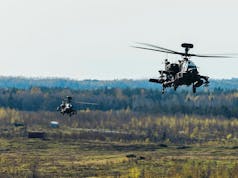MBDA and its partners in the DragonFire consortium say that they have successfully carried out the first static high-power laser firing of a sovereign UK capability at the range in Porton Down.
The test was carried out on the 17th October 2022.
Using QinetiQ’s phase-combined laser demonstrator, generating in the order of 50kW of power, focused by Leonardo’s Beam Director and delivered using MBDA’s advanced image processing and command and control (C2) system, the trials showed that DragonFire could safely control and focus a high power laser onto an extremely precise point at long range.
The firing was part of a second set of tests in a series of trials to prove the accuracy and power of the novel DragonFire laser weapon. The earlier set of trials, announced in July 2022, proved DragonFire can successfully track, and hit, air and sea targets with exceptionally high accuracy.
Chris Allam, Managing Director of MBDA UK, said,
“These successful trials are the latest step in accelerating delivery of a UK sovereign laser directed energy weapon (LDEW) capability. MBDA, Leonardo, QinetiQ and Dstl working together are putting the UK at the forefront of research & technology in this field. The results from these trials have verified analysis and given the team confidence that DragonFire will offer a near term and unique capability.”
The next step will be to combine the outcomes of these first two trials, pairing the proven tracking accuracy and the high power laser, by engaging targets in operationally representative scenarios.














Just waiting for the demonstration videos to come out.
Theres an accompanying video, they dont show any firing they also say the range is classified.
Oh yeah. https://www.youtube.com/watch?v=azpFwRgnz0w
Lots of “classified” things on the range at Porton though they are all viewable on GE, unless they’re underground.
Interesting where they set up, at 2.01 on Colls film you can pinpoint easily where on the Porton range.
https://www.google.co.uk/maps/search/porton+down/@51.1125714,-1.704071,182m/data=!3m1!1e3
The range really depends on the weather
Testing did indeed occur during heavy rain.
Story in the paper today said it shot down a drone 2 miles away.
Britain’s first LASER death ray shoots down drone from two miles away https://mol.im/a/11416413 via https://dailym.ai/android
More power generated that for a rail gun? Properly focused that is quite something.
Nothing like. Railguns need power in the MegaWatt range. This is 50Kw.
It’s being tested in the UK. so I think we can say it has passed that testing. lol
XD
I’m impressed. I can’t wait for the third set of tests, high power in motion.
So no more need for all manner of current military assets then, as this laser could potentially take out anything?
50 kW isn’t enough to take out “anything”, just some things.
The first issue is dwell time on target. The less the power, the longer the beam has to dwell on the target. As the range is also limited by the power as well as the environment, the beam has to interact over a number of seconds between its limited range and before a missile or drone reaches a position to do damage. Cheap ISTAR drones are fair game at 50kW. Fast attack craft, helicopters and so on are going to be inconvenienced.
The US is looking at testing 300 kW lasers and estimates that a 1 MW laser could knock out most things in a second. We’ll have to see what Dragonfire can do in the real world.
US system in development for their ships is 60kw, its a successor to an earlier 40kw prototype system. The 300kw is a truck mounted AA weapon for ground forces and like with Dragonfire’s growth plan its a composite beam weapon taking several smaller lasers and combining them into one beam. Most agree the 1MW airborne laser was a bit of an evolutionary dead end due to its size, filling an entire 747 (That was a successor to a 1980’s prototype that put a 100kw laser on a 707 and shot down some Ballistic missiles).
Israel has also fielded a truck sized 1kw laser named Light Saber as part of Iron Dome for shooting down balloons with incendiaries tied to them. And is working on a system called Iron Beam where two separate 50kw lasers are focused on the same target at a range of upto 20km and an effective destructive range of 7km against mortars and missiles with 4 second illumination.
This is a static test of the Dragonfires 60kw laser in 2017:
https://youtu.be/scBBG3GuQgk
Remember though we are only developing Dragon Fire to make it look like we are doing something while just waiting to see what we can buy off of an over priced US defence contractor.
We are not trying to develop a weapon, the UK a has given up on such things merely keep design teams going for no reason that to keep design teams going.
That’s not at all correct.
Oh, I appreciate the fact that it is only a low power weapon right now, but in due course it would knock out anything.
However, the more relevant issue is the fact that other than the ‘design/theory’ stage these things are going through, I don’t suppose the defence industry will take too kindly to them.
Maybe when the US launches the USS Enterprise into low earth orbit, it will be better suited.
Line the coast of the UK and gunwales of Royal Navy ships with those hand-held lasers that have been made illegal. I mean, they say they can ground aircraft 😂
Well they can ground aircraft… And are dangerous. Civilian pilots do not have helmet visors or ejector seats and are responsible for the safety of hundreds of passengers. Military aircraft not so much…
https://www.youtube.com/watch?v=Eoj3H7LMy2k
Ianbuk we had an Argon Laser fitted in 82 during Corporate lots of money and Wattsge involved probably had the same effect as s B+Q laser aligned spirit level that you can pick up safely hold in your hand instead of 6ft long casing mounted on the gunwhale as we had and all it was capable of was Dazzling not frying We all thought at the time we’d be Battlestar Galatica and that was 40yrs ago
An interesting thing on the ‘dazzlers’ were that they were not designed to ‘dazzle’ the pilots eyes as that would have been illegal under the Geneva Convention. What they did was react with the tiny scratches that are on any aircrafts canopy. The reaction of the laser light on all these thousands of tiny, near invisible scratches, was to fluoresce. Essentially the pilot lost vision throught the canopy completely, the effect was apparently like the canopy becoming opaque with light. THe pilot with no vision would have the choice of crashing or pulling up and aborting an attack run on the ship.
Thanks rudeboy , all I cam remember about it was running the cables throughout the ship hoofing great things too take the Ampage and when connected up to the Amplifiers and switch too run watching the greenbeam emitted from the Laser and everyone going ” ooh wheres the whooshing sound like in the movies” other than that only those in the know knew it’s possible capabilities
Pew pew pew
Due to cut backs, just Pew pew…
😆
Jury Highly Commended Prize.
😂😆
Could be quite effective against optical/IR sensors on aircraft and AShM’s.
Lasers in this power range provide two capabilities. The first is as a supplement to anti-missile and anti-drone point defense that seems to be more accurate than a gun CIWS but doesn’t exhaust limited and costly missile magazines. The second is the ability to deploy precision fire in non-war situations where spraying bullets or shells or missiles may be overkill, e.g., to stop a small boat. Also, any laser demands high-quality optics, which can be used without firing the laser; having an extra trainable mount of this sort is always welcome on a ship.
Laser weaponry will truly come of age much later this century when and if this class of weapons lasers that rely on a continuous beam to heat up the target (requiring dwell time) are replaced by ultrashort pulse lasers that are presently on the horizon (i.e., still in the laboratory and needing a building to power them). When and if efficiency improves – which it likely will eventually – an USPL will be able to dump all its energy into the target instantly, producing effects comparable to conventional weapons such as autocannon but with unparalleled accuracy.
Believe Laser/Directed Energy Weapon collaborative research is one of the specific areas covered under auspices of AUKUS treaty. UK is home to two of the top ten universities in the world; presumably each has a very credible applied physics department. Strictly guesswork, but would not be surprised if pace of combined research program accelerates substantially, w/ a pacing requirement of anti-hypersonics defense. Not certain what proportion of program would surface in open press. 🤔
Hypersonics vs. lasers are an interesting match, and certainly will drive the programs to higher power levels as very little else can reliably and affordably deal with the threat. Still, something like Dragonfire is not ont he table; you’d need 250+ kW (to reduce dwell time) to stop a hypersonic threat with a conventional high energy laser, a power level that is indeed emerging with current research. The future of hypersonic defense is probably multiple networked laser weapons (e.g., several ships or stations fitted with a laser). The relatively high cost of hypersonics means that lasers may not face overwhelming numbers, so a ship or base with a couple of 250 kW+ laser weapons if mounted with a good field of view might have a decent chance at stopping a hypersonic attack on its own.
Understood. Sorry, should have made my point more explicitly, concur w/ your analysis w/ exception of timeline…”much later this century”…Believe development will be much faster; Uncle Sugar will be willing to expend copious amounts of coin of the realm on this venture.
I think that is quite possible. Certainly, conventional weapons in the 100 kW to MW range will be deployed over the next decade.
I’m somewhat optimistic about pulse lasers, but then again, I thought railguns were going to move ahead, and we saw that come to a crashing halt. High-energy pulse lasers seem to be further behind them, though don’t seem to have the baggage the former do. On the other hand, 10 years ago I was seeing almost nothing about the tech outside of sci-fi speculation, and in the last few years, I’ve noticed an upsurge in serious mention of it. (Oddly enough, ultra-short duration pulse laser technology could see some synergy from nuclear fusion research, as high-energy ultra-short pulse laser tech is one path to a working reactor.)
While naval vessels and dedicated AAA ground vehicles are the initial high energy laser users, in the mid-term, I would not be surprised if at some point most sizable land or even air vehicles have a RWS or pod with a conventional high-energy laser CIWS system in the 50-250 kW range for drone or missile defense, if only because as kamikaze drone swarm technology proliferates it may be necessary to have something with a deeper magazine than otherwise possible; they’d also be useful against guided mortar shells, etc..
It will be interesting to hear what these can actually do in practice. Laser light is fast, but its effectiveness relies on a burning action, which takes time. The question is can the laser keep a lock on the missile long enough to burn through the casing and do some damage. Guess we will probably never know, as a major naval war seems highly unlikely.
Uhh…hope those don’t prove to be (in)famous last words…🤔😳🤞
These aren’t just naval weapons. The first real kill I’m aware of was a Turkish 50 kW laser in Libya fired from a ground vehicle, taking out a Chinese drone. Not a ship in sight.
Yes, that was one of the purposes of the previous test. To see if could maintain the laser”spot” on a moving target within a given area.
As has been stated, Dragonfire has proven that it can maintain its track and focus on a target by specifically illuminating a designated area at distance.
In layman’s terms, this means it can maintain and focus on a specific part of a target. Thereby increasing the relative dwell time and speeding up the burn through process.
According to Qinetiq, producing a high intensity fibre laser has not been the problem. The problem has been the collimating optics used to focus the beam on the target, especially one that moves quickly. By all accounts these problems have been solved and they are moving on to the next stage of the program.
Do we know what it was able to target on? How fast a moving target it was? I am thinking back to the US cold war days where they had to use static drones with radar enlarging wraps to get their stupid expensive anti air tank to hit it. It managed but couldn’t achieve the same thing under more realsitic test and so was eventually canned.
Unfortunately they haven’t given out any specifics about the target or targets. For all we know it could have been a dude driving a Landy with a target on the side, though that’s very doubtful.
Reading between he lines, Qinetiq did say one of the targets was moving very rapidly. So it could be “assumed” that the target was one of their target drones, such as a Banshee. This would have been ideal, as they can be fitted within various sensors along with telemetry feedback.
It’s an interesting fact that for all that anti-missile missiles have been deployed for many years, very few examples of even a missile shooting down an anti-ship missile have happened. I suppose the main risk of a naval war against a power likely to have lasers deployed is a Taiwan invasion situation, and hopefully that will never happen.
On the other hand, Israel’s iron beam is supposed to be operational in 2-3 years. It’s a 100-kW laser, and claims about 3-5 seconds to destroy a missile or rocket. With Hamas likely to continue shooting rockets into Israel, barring any developments that see the cancellation of the project, I expect some “live fire” examples will ensue.
3 in the top ten. Imperial are currently rated 10th. 4 in the top 25. Which is actually a decline…a few years ago it was 4 in the top 10.
In other lists its 4 in the top 10 and 5 in the top 25. Still a decline in the top 25…but thats what 10 years of a Conservative government gives you…
Nothing to do with Conservatives. University’s are autonomous and over the last 10 years have been almost entirely extreme left leaning – selling useless degrees by the thousand for pots of cash with very little eye on quality.
Imperial college is probably more up on the engineering/hardware side. Oxbridge will sort the theoretical physics out.
I wouldn’t be too sure about that.
In some science areas Imperial or UCL are in front of Oxbridge. Same with Edinburgh.
Thing is that you are talking about getting 3-5 really good profs together in one department for a protracted period. Sure departments go up and down all the time as senior staff cycle through.
Research money follows the people and their ideas, networks and connections.
So there will be real excellence is some very out of the way university departments in very specific areas.
In reality, believe there will be a research consortium w/ everyone becoming a subcontractor to DARPA/ONR/AFOSR (may/may not be current titles), which all will have the proverbial deep pockets. Entrepreneurs, please take note.
Additionally, AFRL (dasn’t forget my old compadres). 🙄
I see weapons-grade laser development as being in the province of engineers, rather than scientists.
Nice to see this is still moving forward…
I quick search of the internet suggests that laser cutters are typically in the 3 to 6kW range. Of course these don’t have to work over any kind of range, but it gives an idea of the power on target required to physically damage something. Should also note that laser cutters have plenty of time to get the job done…
Much of the power Dragonfire generates is likely lost in transmittion, hence the need for high power lasers. Oh yeh, and the target might do something unsporting like maneuvre to change the engagement geometry thus disipating the laser effect, remember the laser is likely very focused even at range so a rapid roll might just be enough.
This is all very early days and we won’t really know how effective these things are until we find out what the target set really is…
My guess is they are primarily aimed at IR homing / imaging warheads i.e. fry the seeker. Now that is much more likely at this stage of development I think.
Cheers CR
Seems like an aweful lot of money for something that I have only ever seen take out a small dinghy.
Is £30m really an awful lot of money in defence terms? Also given that they haven’t released videos of the high energy tests, why do you talk about only ever seeing it taking out a dinghy?
Jon, I note that the system was supposed to be delivered in 2019 so 3 years delay?
Maybe more. It’s not fully demoed yet. Contract was in 2017 for testing in 2018 and delivery in 2019 — a tad optimistic. There were a couple of years when it went deathly quiet and everyone was worrying they’d cancelled it.
Just thinking about what I wrote there, the Thales/Raytheon contracts in 2021 were for integration/delivery next year, so the same short two-year timescale as the Dragonfire contract.
The Thales consortium’s integration on the Type 23 is supposed to help in figuring out RN operation and maintenance requirements, so I’m guessing it won’t be as powerful as Dragonfire. Ditto Raytheon’s for the Army.
Small boats (especially drones) can sink big ships…
I finally found the £30m figure from Georges 5 Jun 2017 article.
Of course that is not the cost of 1 x Dragonfire – most of that is R&D and Non-Recurring Engineering costs.
Ahh, Porton, wondered where this asset was….
Bursting the clouds for better communicationNew tech can bore a hole in clouds to pave the way for laser-transmitted data from a satellite
https://www.sciencedaily.com/releases/2018/10/181017111033.htm#:~:text=Lasers%20can%20also%20be%20used,cannot%20penetrate%20clouds%20and%20fog.
Also study by Sandia from the 80’s which was looking at satellite power stations, they found a 10-50MW laser would bore a 1m wide hole through clouds from orbit, now modern lasers your only needing a 1cm hole potentially one hundredth the power, which would be about… 50kw. Now the reason all the laser projects are in the 40-60kw range makes sense.
A 1cm wide hole is 10,000 smaller than a 1m wide one and one hundredth of 50MW would be 500kW but yes, tighter beamwidth means less need for higher powers 🙂
Yeah 1cm circle 10,000th of 1m and 10,000th of 50MW is 5kw, don’t know why I said hundredth.
1 meter = 100 centimeters; otherwise, calculation correct based upon Sandia’s data: 100KW – 500KW.
1cm is 100x smaller than a metre, yes, but 1cm^2 is 100^2 (10,000) times smaller than a m^2.
So, if power requirement truly proportional to area requirement, the estimate would be 1KW – 5KW, based upon Sandia’s calculated requirements? Still uncertain how this would translate in terms of effects on weapons in real world conditions? 🤔
No, 10KW – 50 KW.
Oh hell, it is 1KW – 5KW. 🤔🙄
So I would speculate that the laser is modulated between moisture bursting and heating/lasing the target in those cases?
50 Kw is going to allow you to hit small boats and drones (Slow Speed) out to possibly 3-5 Km. It will also damage and blind optics on targets at ranges greater than that.
To hit and destroy fast targets at a decent range the power requirements go up considerably. For something like a conventional cruise missile you are looking at 200/500Kw. Hypersonic /Ballistic missile defence is in the multi megawatts bracket. Those power outputs and the practical user friendly technology to produce them is still 10-15 years in the future.
As power goes up then you get more issues such as onboard cooling systems, power management and power storage.These are manageable engineering issues.
The next issue is Physics. You cannot change the laws of Physics and they are restrictive. Atmospherics and environmental’s become a big issue. You get thermal blooming issues , particulates in the atmosphere and the old favourite of water vapour. Water vapour absorbs light of certain wavelengths. There are “windows” in the light spectrum at which certain wavelengths are less affected by absorption. These windows are well known and are utilised by Thermal Imagers etc allowing them to see. Lasers will need to use these windows to get a decent range.
Turbo Lasers are a long way off but for dealing with close in simple targets Dragonfire will be ideal. Plenty of magazine depth and You wont need to use a 300K GBP missile on a cheap 10K drone.
Largely concur, engineering issues are solvable, given sufficient time and budget (Uncle Sugar’s role); physics issues hopefully solvable, but could prove to be a bitch. 🤔
Turbo Lasers are a long way off, perhaps in a galaxy far, far away? I actually searched for turbo laser to see if that was a real thing. So we’ve no need to worry about paying for a Deathstar yet. I can imagine Ben Wallace trying to get that one past cabinet.
Wallace: I felt a great disturbance in the Force, as if millions of voices cried out in terror and were suddenly silenced.
Sunak: I knew we should have spent the money on a mid-winter heating allowance.
😆 That deserves a like!
Brilliant!
According to Grim Reapers on YouTube, 10x B1s can take out a star destroyer if they are high enough. 😂
Mr. Scott, where are my damned shields and photon torpedoes? Oh wait, wrong sci-fi franchise…😉
It’s going to be interesting seeing the cost of Dragonfire.
I suspect we’ll see one mounted on land at Faslane in due course….
I’d guess the next one we’ll see in Scotland will be the Raytheon Wolfhound-mounted laser, as Raytheon are basing their high energy laser centre in Livingston.
One method that could be used is a networked laser. Much like how a fibre laser works by merging lots of smaller ones together. This can also be achieved by focusing more that one laser on a target. The combined effect will be similar to a singular massive laser. But on the plus side your cooling and power needs will be more spread out and easier to maintain. The other bonus is that you will suffer less dilution of the spot’s intensity. So the spot’s dwell time can be reduced. The disadvantages is coordinating the laser network onto a particular target area, plus finding space for multiple lasers and it’s support infrastructure. But a networked laser is more achievable in the short term.
Excellent cost effective way for taking out cheap drones.
So, it’s a “phaser”? Mr. Worf, fire!
🤔😳😁
A bit of progress in the right direction, as other posters have pointed out here, 50KW is good for slower-moving targets, such as drones and small surface vessels. Much more power will be needed to deal with missile threats.
Good news. Let’s hope it works and gets deployed. Is this primarily aimed at drones and other small(ish) vehicles, or will it have wider applications? My next question reveals my ignorance, but I’ve always wondered how the enormous energy transmitted doesn’t destroy the projection device itself? Does it for example require masses of cooling while lasing?
I understand they needed to put considerable effort into the aiming mirror technology to avoid that issue, with special thought put into the materials to avoid the mirrors being destroyed.
Thanks! I’m sure big time cooling is also necessary
Yes, mirrors in particular take a battering. As after a certain amount of time their reflectivity starts to fade. This is caused due to the fact that mirrors are not 100% perfect and absorb some of the light, that then is converted into heat. This causes the material over time to warp.
Similarly if the laser uses a diode to generate the light. These are at best 40% efficient. The remaining 60% is generated as heat, which then needs cooling. You can ramp up the efficiency by using refrigeration. But then you need space for the cooling circuit, evaporators etc.
Things have come a long way since the RN first mounted a laser on a photography tripod and pointed it at a Soviet Bear to dazzle the cameras. The event was recorded by Janes.
Can anyone remind me what year it was and which ship was involved?
I think it was a frigate, if that helps.
A dazzle laser was deployed to the Falklands but probably wasn’t used. The military HE laser programme started properly in 1974, so my guess is it would have been first trialled in the late ’70s. Laser target designators came first and were used in the Falklands.